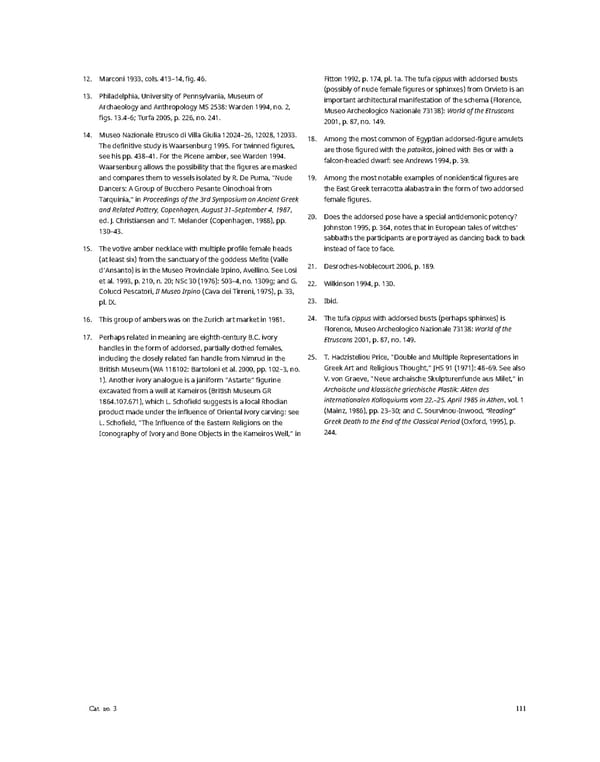12. Marconi 1933, cols. 413–14, fig. 46. Fitton 1992, p. 174, pl. 1a. The tufa cippus with addorsed busts 13. Philadelphia, University of Pennsylvania, Museum of (possibly of nude female figures or sphinxes) from Orvieto is an Archaeology and Anthropology MS 2538: Warden 1994, no. 2, important architectural manifestation of the schema (Florence, figs. 13.4–6; Turfa 2005, p. 226, no. 241. Museo Archeologico Nazionale 73138): World of the Etruscans 2001, p. 87, no. 149. 14. Museo Nazionale Etrusco di Villa Giulia 12024–26, 12028, 12033. 18. Among the most common of Egyptian addorsed-figure amulets The definitive study is Waarsenburg 1995. For twinned figures, are those figured with the pataikos, joined with Bes or with a see his pp. 438–41. For the Picene amber, see Warden 1994. falcon-headed dwarf: see Andrews 1994, p. 39. Waarsenburg allows the possibility that the figures are masked and compares them to vessels isolated by R. De Puma, “Nude 19. Among the most notable examples of nonidentical figures are Dancers: A Group of Bucchero Pesante Oinochoai from the East Greek terracotta alabastra in the form of two addorsed Tarquinia,” in Proceedings of the 3rd Symposium on Ancient Greek female figures. and Related Pottery, Copenhagen, August 31–September 4, 1987, 20. Does the addorsed pose have a special antidemonic potency? ed. J. Christiansen and T. Melander (Copenhagen, 1988), pp. Johnston 1995, p. 364, notes that in European tales of witches’ 130–43. sabbaths the participants are portrayed as dancing back to back 15. The votive amber necklace with multiple profile female heads instead of face to face. (at least six) from the sanctuary of the goddess Mefite (Valle 21. Desroches-Noblecourt 2006, p. 189. d’Ansanto) is in the Museo Provinciale Irpino, Avellino. See Losi et al. 1993, p. 210, n. 20; NSc 30 (1976): 503–4, no. 1309g; and G. 22. Wilkinson 1994, p. 130. Colucci Pescatori, Il Museo Irpino (Cava dei Tirreni, 1975), p. 33, pl. IX. 23. Ibid. 16. This group of ambers was on the Zurich art market in 1981. 24. The tufa cippus with addorsed busts (perhaps sphinxes) is Florence, Museo Archeologico Nazionale 73138: World of the 17. Perhaps related in meaning are eighth-century B.C. ivory Etruscans 2001, p. 87, no. 149. handles in the form of addorsed, partially clothed females, including the closely related fan handle from Nimrud in the 25. T. Hadzisteliou Price, “Double and Multiple Representations in British Museum (WA 118102: Bartoloni et al. 2000, pp. 102–3, no. Greek Art and Religious Thought,” JHS 91 (1971): 48–69. See also 1). Another ivory analogue is a janiform “Astarte” figurine V. von Graeve, “Neue archaische Skulpturenfunde aus Milet,” in excavated from a well at Kameiros (British Museum GR Archaische und klassische griechische Plastik: Akten des 1864.107.671), which L. Schofield suggests is a local Rhodian internationalen Kolloquiums vom 22.–25. April 1985 in Athen, vol. 1 product made under the influence of Oriental ivory carving: see (Mainz, 1986), pp. 23–30; and C. Sourvinou-Inwood, “Reading” L. Schofield, “The Influence of the Eastern Religions on the Greek Death to the End of the Classical Period (Oxford, 1995), p. Iconography of Ivory and Bone Objects in the Kameiros Well,” in 244. Cat. no. 3 111
 Ancient Carved Ambers in the J. Paul Getty Museum Page 120 Page 122
Ancient Carved Ambers in the J. Paul Getty Museum Page 120 Page 122